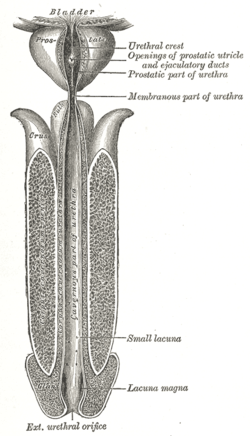Our website is made possible by displaying online advertisements to our visitors.
Please consider supporting us by disabling your ad blocker.
Uretra
| Uretra | |
|---|---|
 Uretra masculina
| |
| Detalhes | |
| Precursor | Seio urogenital |
| Identificadores | |
| Latim | urethra feminina, urethra masculina |
| Gray | pág.1234 |
| MeSH | urethra |
A uretra (em grego clássico: οὐρήθρα; romaniz.: ourḗthrā) é um tubo que liga a bexiga uretral ao meato ureteral para a remoção da urina do corpo tanto de mulheres como de homens. Nas fêmeas humanas e em outros primatas, a uretra se conecta ao meato uretral acima da vagina, enquanto nos marsupiais, a uretra da fêmea deságua no seio urogenital.[1]
As mulheres usam a uretra apenas para urinar, mas os homens usam a uretra tanto para urinar quanto para ejacular.[2] O esfíncter uretral externo é um músculo estriado que permite o controle voluntário da micção.[3] O esfíncter interno, formado pelos músculos lisos involuntários que revestem o colo da bexiga e a uretra, recebe seu suprimento nervoso pela divisão simpática do sistema nervoso autônomo.[4] O esfíncter interno está presente tanto em homens quanto em mulheres.[5][6][7]
- ↑ Hugh Tyndale-Biscoe; Marilyn Renfree (30 de janeiro de 1987). Reproductive Physiology of Marsupials. [S.l.]: Cambridge University Press. pp. 172–. ISBN 978-0-521-33792-2
- ↑ Marvalee H. Wake (15 de setembro de 1992). Hyman's Comparative Vertebrate Anatomy. [S.l.]: University of Chicago Press. pp. 583–. ISBN 978-0-226-87013-7. Consultado em 6 de maio de 2013
- ↑ Legato, Marianne J.; Bilezikian, John P., eds. (2004). «109: The Evaluation and Treatment of Urinary Incontinence». Principles of Gender-specific Medicine. 1. [S.l.]: Gulf Professional Publishing. p. 1187
- ↑ Chancellor, Michael B; Yoshimura, Naoki (2004). «Neurophysiology of Stress Urinary Incontinence». Reviews in Urology. 6 (Suppl 3): S19–S28. PMC 1472861
 . PMID 16985861
. PMID 16985861
- ↑ Jung, Junyang; Anh, Hyo Kwang; Huh, Youngbuhm (setembro de 2012). «Clinical and Functional Anatomy of the Urethral Sphincter». International Neurourology Journal. 16 (3): 102–106. PMC 3469827
 . PMID 23094214. doi:10.5213/inj.2012.16.3.102
. PMID 23094214. doi:10.5213/inj.2012.16.3.102
- ↑ Karam, I.; Moudouni, S.; Droupy, S.; Abd-Almasad, I.; Uhl, J. F.; Delmas, V. (abril de 2005). «The structure and innervation of the male urethra: histological and immunohistochemical studies with three-dimensional reconstruction». Journal of Anatomy. 206 (4): 395–403. PMC 1571491
 . PMID 15817107. doi:10.1111/j.1469-7580.2005.00402.x
. PMID 15817107. doi:10.1111/j.1469-7580.2005.00402.x
- ↑ Ashton-Miller, J. A.; DeLancey, J. O. (abril de 2007). «Functional anatomy of the female pelvic floor.». Annals of the New York Academy of Sciences. 1101 (1): 266–296. Bibcode:2007NYASA1101..266A. PMID 17416924. doi:10.1196/annals.1389.034. hdl:2027.42/72597

Previous Page Next Page


